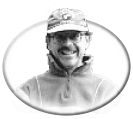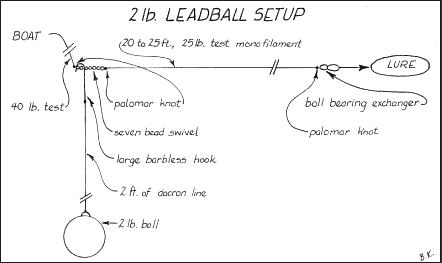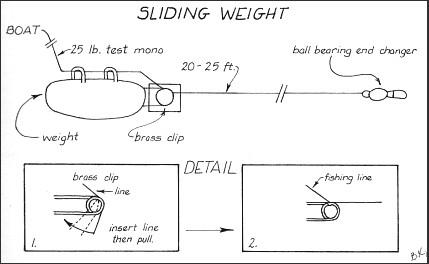
Trolling for Salmon
Part One
with
D.C. Reid
illustrations by Barb Krimmer
Trolling - the pulling of a lure behind a moving boat - enjoys great popularity from one end of coastal British Columbia to the other. The reason isn’t hard to fathom: more fish are caught trolling than all other methods of fishing combined.
Two factors unite to give trolling the edge. From November to May, over half the year, only two
species
of salmon present themselves in coastal waters: Chinook and Blueback coho. Both these resident species disperse across large areas in winter and thus a moved lure contacts more fish in a shorter period of time than a stationary one. Regardless of time of year, it makes sense to search out the fish; trolling has a clear advantage here. A simple comparison of the size of a school - seldom more than 100 yards wide for most species - and the size of the ocean, leads to the realization that only a small portion of the available fishing space actually contains fish. Trolling thus provides a method for finding small fishy pockets in otherwise salmonless expanses of water.
Not surprisingly, more gear finds its way onto the trolling sector of the market than those for other forms of saltwater angling. Water is a dense medium, and drag on trolled gear increases with depth. Much of the variation within a single product and the array of individual products counteracts the drag and resulting stress arising from simply trying to get a lure down to the depth at which the fish lie.
Three distinct types of trolling rods have evolved: stout 6 ½- to 7 ½- foot roller-guided rods; medium-strength conventionally-guided rods of 7- to 8-foot lengths; and lighter 7 ½- to 8 ½-foot fiberglass rods.
Each rod type has specific applications. The grandfather of all saltwater rods, the roller-guided variety is the only one that can withstand the pressure of heavyweight fishing year in and year out without breaking. Typically used with a planer - essentially an upside-down kite that pushes the line down into the ocean - these rods utilize wire line. Wire proves necessary because the pressure of a planer either breaks monofilament line or results in too much line stretch for tripping the planer. These rods will take a lure to 150 feet deep. At this point line drag prevents further gains.
Although gear for the Terminator, roller-guided rods come into their own in calm waters - fjords and bays with little or no tidal flow - where engine noise serves to scare the fish. (Planers often out fish other rod types 3 to 1 in such conditions). The reason is that the lure is 375 feet from the boat at 150 feet of depth. In comparison, lures attached to downrigger lines at the same level are 160 feet from the boat.
The second rod type, the medium-strength fiberglass rod, is used with weights. Three types of weights may be purchased: 1- to 2-pound lead balls; 1- to 12-oz sliding weights; and, 1- to 6-oz banana weights.

Each type of weight has a specific purpose. Lead balls are used to reach depths of 125 feet. A 2-pound ball reaches this depth at 250 feet of line, or a ratio of 1 foot down for every 2 feet let out. Main line should be 40 pound test. Alternatively, a wire line roller-guided rod makes a perfectly reasonable alternative. In either case, the gear set up is the same (
See Diagram
). The main line attaches to a seven bead swivel with a Palomar knot. Over the bead swivel a large barbless hook is strung. Attached to this hook is two feet of dacron line and a lead ball. This arrangement allows for a weight to be removed and for a fish to be played right to the boat. Below the swivel attaches 20 to 25 feet of 25 pound monofilament and then a ball bearing end-changer at the tackle end.
Lighter than lead balls, sliding weights come into their own when fish reside in the top layer of water, roughly the first 30 feet. The advantage with these weights is that they trip when a fish bites, and travel down the line to the terminal end, allowing the fish to be played right into the boat. Great sport indeed to catch a fall northern coho that smacks a small spoon with only a one ounce weight on the line. It’s even more fun when the rod is a 6 foot trout rod adapted with a salmon reel for saltwater use!

Due to their construction, sliding weights may be added to the main line at any point; the line slips under the rails and inserts into the brass clip at a weight’s front end
(See Diagram)
. Note that the brass clip must face toward the lure or the weight will not trip free. Although simple implements for weighting trolled lines, sliding weights have one disadvantage: they nick and weaken the main line where it inserts into the brass clip. This problem can be alleviated by clipping 6 feet from the main line each time out and retying the ball bearing end-changer on the tackle end.
The third type of weight used in saltwater trolling is the banana variety, so-called because it resembles the yellow fruit in shape. With a swivel at both ends, a banana weight ties to both the main line and leader with a Palomar knot. Primarily a piece of mooching gear, banana weights have the nice quality of rarely tangling in fishing line. (They become a trolling weight when a cut plug bait is pulled behind a moving boat). They also afford the use of lighter longer rods, distinctly improving the sport of playing salmon. And sport - large doses of adrenaline - is what fishing is all about.
Read
Trolling Part Two
:
Downrigger Tips, Electric Potential, Reels, and Finding the Fish.
|





